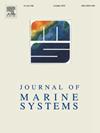Zooplankton seasonal variability in Arctic fjord during cold and warm events – taxonomic and trait-based approaches (Kongsfjorden, Svalbard)
IF 2.5
3区 地球科学
Q2 GEOSCIENCES, MULTIDISCIPLINARY
引用次数: 0
Abstract
Kongsfjorden, located on the west coast of Spitsbergen (79°N), lies at the boundary between Arctic and Atlantic water masses, making it an ideal site for studying the influence of environmental conditions on ecosystem dynamics and offering insights applicable to other Arctic regions. In this study, we describe the seasonal succession and interannual variability of the zooplankton community in Kongsfjorden in quantitative, taxonomic, and ecological terms, as observed during years with contrasting hydrographic conditions. The analysis is based on data collected in 2002, 2006, and 2007—years characterized by pronounced environmental differences, particularly in spring, with notable variation in seawater temperature and salinity. Zooplankton samples were collected from stations within the fjord and on the adjacent shelf using vertically stratified hauls with a Hydro-Bios Multi Plankton Sampler midi (180 μm mesh). Ecologically, the zooplankton community was analyzed using four traits—body size, feeding mode, spawning strategy, and transparency—allowing classification of 115 taxa into ten functional groups. Across all seasons, zooplankton biomass was consistently dominated by non-gelatinous, medium-sized, free-spawning forms. A clear seasonal shift in functional composition was observed, from current feeders in spring to ambush feeders in autumn, reflecting changes in food availability and trophic dynamics. Trait-based patterns proved more stable than taxonomic composition and more effectively captured key aspects of zooplankton functional roles in ecosystem processes, including trophic interactions, carbon export, and pelago–benthic coupling. Although the data reflect conditions from nearly two decades ago, they represent both cold and warm hydrographic states and remain ecologically relevant. Our findings highlight the sensitivity of Arctic zooplankton communities to early-season hydrography and bloom composition, and underscore the value of trait-based approaches for detecting structural shifts and anticipating ecosystem responses under ongoing Arctic Atlantification.
北极峡湾浮游动物在寒冷和温暖事件中的季节变化——分类和基于特征的方法(斯瓦尔巴群岛kongsjorden)
kongsjorden位于斯匹次卑尔根岛西海岸(北纬79°),位于北极和大西洋水团之间的边界,是研究环境条件对生态系统动态影响的理想场所,并提供适用于其他北极地区的见解。在本研究中,我们从数量、分类和生态的角度描述了在不同水文条件下Kongsfjorden浮游动物群落的季节演替和年际变化。该分析基于2002年、2006年和2007年收集的数据,这些年份的环境差异明显,特别是在春季,海水温度和盐度变化显著。采用Hydro-Bios Multi Plankton Sampler midi (180 μm目)垂直分层运输,在峡湾内和邻近大陆架上采集浮游动物样本。生态学上,利用体型、摄食方式、产卵策略和透明度4个特征对浮游动物群落进行了分析,并将115个类群划分为10个功能类群。在所有季节,浮游动物生物量始终以非凝胶状、中等大小、自由产卵的形式为主。观察到功能组成有明显的季节变化,从春季的当前摄食者到秋季的伏击摄食者,反映了食物供应和营养动态的变化。基于性状的模式被证明比分类组成更稳定,并且更有效地捕获了浮游动物在生态系统过程中的功能角色的关键方面,包括营养相互作用、碳输出和远洋-底栖耦合。虽然这些数据反映的是近20年前的情况,但它们代表了寒冷和温暖的水文状态,并且仍然具有生态相关性。我们的研究结果强调了北极浮游动物群落对早季水文和水华组成的敏感性,并强调了基于特征的方法在正在进行的北极大西洋化中检测结构变化和预测生态系统响应的价值。
本文章由计算机程序翻译,如有差异,请以英文原文为准。
求助全文
约1分钟内获得全文
求助全文
来源期刊

Journal of Marine Systems
地学-地球科学综合
CiteScore
6.20
自引率
3.60%
发文量
81
审稿时长
6 months
期刊介绍:
The Journal of Marine Systems provides a medium for interdisciplinary exchange between physical, chemical and biological oceanographers and marine geologists. The journal welcomes original research papers and review articles. Preference will be given to interdisciplinary approaches to marine systems.
 求助内容:
求助内容: 应助结果提醒方式:
应助结果提醒方式:


